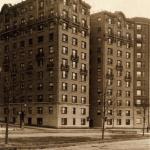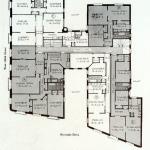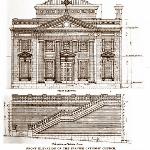Rhinecleff Court (788 Riverside Drive)
Now, from this same spot on Riverside Drive, turn your attention back across the street, to Rhinecleff Court, the second eleven-story apartment building from the right. Notice how the cornice line continues that of its neighbor, The Vauxhall and the building materials of the two buildings complement each other.
Designed in the Beaux arts style by Schwartz and Gross, who also created the Audubon Park Apartments that you saw on Broadway, this building dates from 1911 and had a construction cost of $400,000. When you view the façade from a distance, as you are doing now, the deep court dramatically projects a full-height entry to the building. Up close, of course, the entry doors reach only one-story. The apartments on either side of this entry courtyard mirror each other, symmetry that director Noel Black used to great effect in the 1989 teleplay, The Hollow Boy, based on a short-story by Hortense Calisher and filmed in this building.
Now, continue to the corner, turn to the right, and start up this side of 156th Street. After you pass a side entrance to Rhinecleff Court and a solitary brass door, you will come to three pairs of embossed brass doors.This is the exterior entrance to an auditorium that serves the American Academy of Arts and Letters. Tim Robbins used this façade, disguised with a marquee, and the surrounding streetscape in his 1999 film, Cradle Will Rock.
Nuestra Senora de la Esperanza
A few steps further and you have reached Nuestra Señora de la Esperanza. Archer M Huntington, the philanthropist who developed the Audubon Terrace complex donated the land for this church and gave $50,000 towards its construction, approximately half of the total cost. Charles P. Huntington designed the original structure, which was consecrated in July 1912. The original church, in the Greek Revival style, was quite different from what you see today. At the sidewalk, a long flight of stone stairs began at the left side and rose to the right, across the entire front of the church, ending at a broad porch surrounded by a low stone balustrade. Four Ionic columns supporting a cornice and pediment sheltered the main doors. In the 1930s enlargement, upper and lower vestibules replaced the dramatic stairs and porch. In place of the entry pavilion, double doors open off the street with statuary in niches on the simple façade rising above.
Cardinal Farley presided at the consecration of this church, and in his homily alluded to some infighting in the congregation. Calling for unity, he said, “In this church let there be no North and South among you, as we say here. Let South Americans, Cubans, Mexicans and Spaniards all come here without thought of racial distinction and kneel together as Catholics.”
There is a project on foot to build a Spanish Roman Catholic Church near Audubon Park, at 156th Street...Miss Maria de Barril has arranged to have a concert benefit given to raise funds for the building. Mme. Emma Eames, assisted by Emilio de Gorgoza and Victor Herbert and his full orchestra are to be the artists.
New York Times
April 11, 1907
Nuestra Senora de la Esperanza
The church is often open (ring the bell if it is not) and the staff will allow you to explore the interior. Nuestra senora is an active church, so services may be in progress.
The interior is exquisite. From today's lower vestibule, stairs lead another vestibule on the upper level and then into the church, where a magnificent lamp, which King Alfonso of Spain presented in when the church was new in 1912, dominates.
Above it is a splendid stained-glass skylight. Along either side are three stained glass windows, though many lack sufficient sunlight to fully illuminate them. To the right of the altar is a painting of Jesus and Joseph, executed and presented by the famous Spanish artist Sorolla, whose magnificent murals are on display in the Hispanic Society.
Zuologa, another Spanish artist, promised to paint a picture of the Virgin, Our Lady of Hope, which was to be hung behind the altar, but he died before he could complete it.
 | ||||
The "Spanish Church" Design
(click to enlarge)
 | ||||
 | ||||
Rhinecleff Court circa 1920
(click to enlarge)
Rhinecleff Court Floorplan
(click to enlarge)
Continue your walk . . .
Funded by the Audubon Park Alliance


